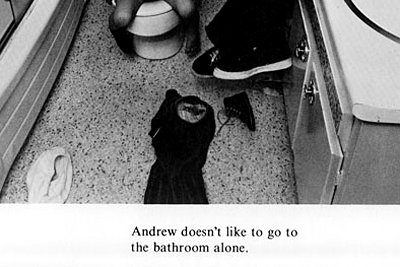Project and
Methods:
Probes:
Cameras:
Image + text, and self reporting cameras
Every study surveyed that used some sort of activity pack included either a disposable camera or an instant film camera. The cameras are used in basically the same way in all the studies: to collect textural images and to document events the researchers could not be present for. The cameras themselves can either be left as they are to use their familiarity to comfort the user, or altered to recast the camera away from being an ordinary object and thus encourage new ways of looking at the photo taking task.
 Detail from a Bill Owens photo. Owens asked the subjects in his photos (often his friends and neighbors) to annotate the images after they were taken.
Detail from a Bill Owens photo. Owens asked the subjects in his photos (often his friends and neighbors) to annotate the images after they were taken.A discussion of this subject by the Living Profiles team led designer Hannah Regier to create a system of mobile phone blogging in which teens took photos from given prompts, uploaded them to secure private blogs, and then annotated them online with text entries. This approach was made possible by using an expensive, imported mobile phone that could easily send photos to the secure blogs. It meant purchasing several phones and paying for service for all of them. While it returned good image and text combinations, it was prohibitively expensive for WWP.
Instant cameras were considered. They would allow for images to be taken and then annotated immediately. However, the participants would have an opportunity to self-edit photos they didn't like and if too much editing happened they would run out of film before taking all the photos. Digital cameras used with email were also considered but were thought to have too high a chance of failure.
 The camera and shot list included in the activity pack. The other side of the shot list includes instructions and camera tips.
The camera and shot list included in the activity pack. The other side of the shot list includes instructions and camera tips.
Technical notes.
Disposable cameras vary widely in their construction quality, depth of field, minimum focus distances, need for flash, and film quality. The camera used for WWP was not well selected. It had a distant minimum focus and a flash that would go off uncontrollably. This led to many poor photos. Also the cameras were mailed several times (to the participants, back to the researchers, to the photo lab) and several of them cracked open, ruining part or all of the photos within. This isn't just disappointing--these photos could shape the visual outcome of the research--having the best possible photos is a benefit.